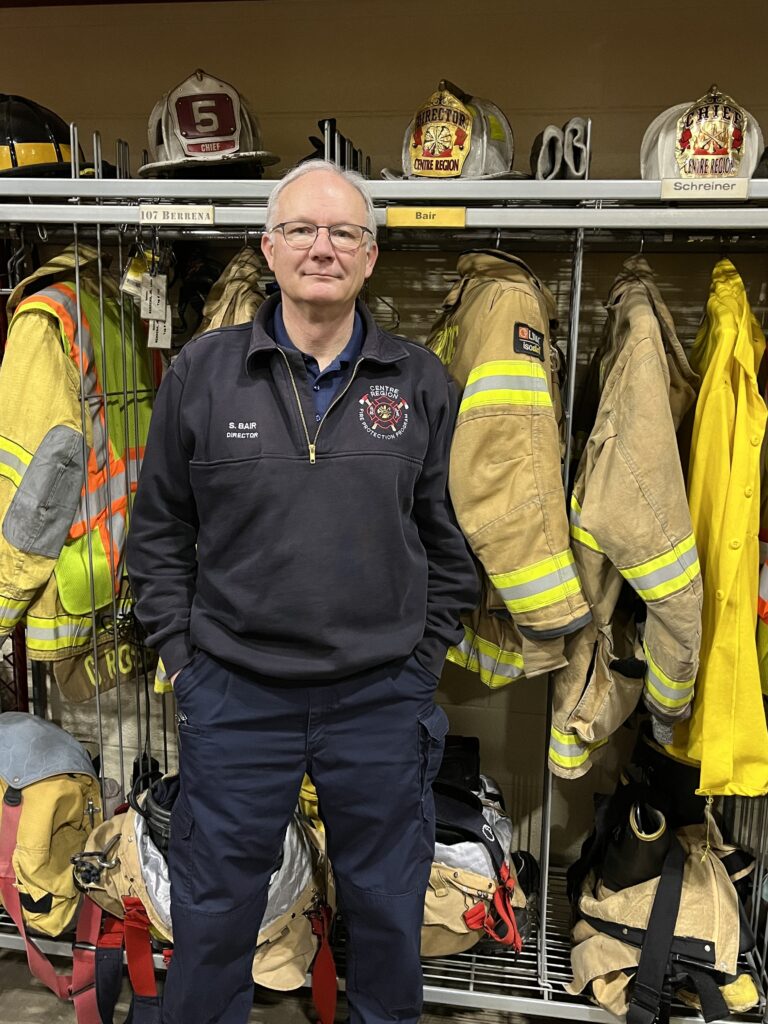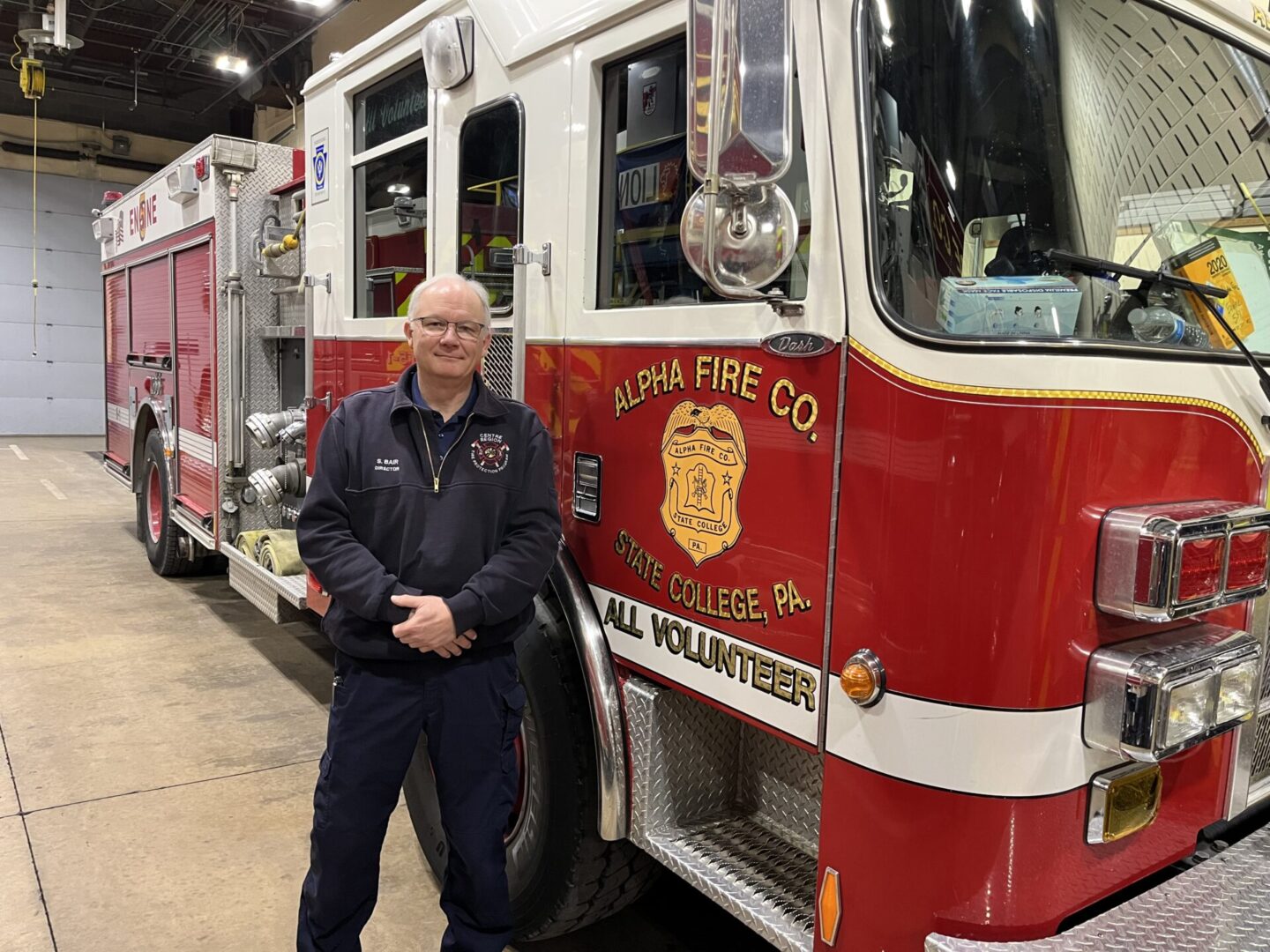Steve Bair loves helping people, but he acknowledges that he isn’t a fan of waiting to see the results of his work.
So, what better way to contribute than in the fire service?
Bair first volunteered in 1975 at age 17 in Lower Paxton Township and was quickly hooked.
“I think the thing that I really like about it the most is that it is instantly gratifying,” he says. “When someone calls 911, you’re an instant good person when you show up. You can screw that up, but you’ve got to work hard at it.”
After 47 years of helping make problems go away—the last 16 as director and chief of the Centre Region Fire Protection Program—Bair retired at the end of the year. The program Bair has overseen includes Alpha Fire Company, Centre Region Fire Marshals, Centre Region HazMat, and Centre Region Emergency Management.
Before coming to State College to make the fire service a full-time career in 2007, Bair—a mechanical engineer—spent 31 years as a volunteer in Pennsylvania and New Hampshire while working in the electronics industry. (He has a degree from Pitt, of all places. “How I ended up here, God knows,” he says with a laugh. “We have a lot of fun with that sometimes.”)
Bair says he’s proud of the department he’s leaving but warns of significant challenges ahead for fire and EMS services around the state as they grapple with dwindling numbers of volunteers and the costs associated with hiring paid first responders.
The Alphas have five paid personnel (the fire director, three assistant chiefs, and an equipment technician; the program also includes a paid emergency management coordinator) and 92 volunteers serving about 93,000 people. The company covers a 104-square-mile area that includes the borough of State College; the townships of College, Ferguson, and Patton, along with a portion of Benner; and the Penn State campus.
“By any measure, we are an incredibly good value to the taxpayer,” Bair says. The annual per-capita cost of the service, excluding Penn State students, is about $32 (it varies some by municipality), which he says is perhaps the lowest such cost for the level of service in the state.
“We run a well-disciplined, professional ship here,” he says. “It was a good fire company when I walked in. I think it’s a better fire company today. I hope my successor comes and makes it an even better fire company.”
Here are some other highlights of our discussion:
What have been the biggest changes you’ve seen, both in the area and in how that impacts the fire service, since you started here in 2007?
Bair: The biggest, most impactful thing is the manner of growth. If you go back and you look at the 2000 census, the 2010 census, and what I’m seeing from the 2020 data that’s available … there’s actually two changes. First of all, the urban core has become more urbanized. That’s the obvious one. And that has an effect on the fire department. But the biggest effect on the fire department is the fact that the fastest-growing segment of the adult population is over 50. … [It’s a] nice place to retire.
That’s the death of a volunteer fire department because nobody who’s 50 and over is coming to join the volunteer fire department, right? So, if you look at our adult population by age, you have this perpetually college-age group, obviously. And in the last census, it grew about 4 percent, which magically is about what Penn State’s enrollment grew here. And that’s highly transient. And then you’ve got this big 50-and-over group, which in the 2010 census grew 37 percent; I think it’s pretty much on track for pretty close to that again. So massive growth and all the growth in the adult population is 50 and over and there’s no middle. The fire company needs the middle.
So, what’s happening is the volunteer fire department is just simply going to run out of volunteers. That’s not going to happen tomorrow, or next year. A decade from now this will still be a mostly volunteer fire company, I’m pretty confident. Our hiring projections have us pulling in maybe nine [paid] firefighters over the next five to seven years.
Alpha responds to about 1,300 calls a year. How does that compare to when you started?
Bair: When I first got here in 2007, I think we were hovering around 700, 800. It’s grown quickly. But that comes with the population and the complexity of the infrastructure. Now add to that a couple of really big events. We’re throwing the biggest party of the year eight times a year here. We become the third-largest city in the state eight times a year because even Blue-White [Weekend] is bouncing back.
That’s just football. Think of the other things. Ag Progress Days draws a lot of people here; we host things like PIAA tournaments. There’s just a lot of stuff here … big-name concerts coming through town.
Those events—a Penn State football game, for example—really increase your call volume?
Bair: Human beings are the biggest cause of fire calls because they crash and do stupid things. We’re a flawed species; what are you going to say, right?
By 2024, the department is looking to hire some [rank-and-file] firefighters?
Bair: The math is pretty easy. We have people who are aging out of the system, and we have people coming in, and the flow of people in is not keeping up with the people aging out. … We’ve struggled to fill some weekends. We’re starting to see some cracks in the armor. But by the end of [2023], those are going to be genuine gaps that are going to have to be filled.
You end up with the reality that you’re going to have to start to salt this thing with career personnel. And in my last meeting with the [Centre Region Council of Governments] Finance Committee, I said, “My parting words of wisdom to you all is you need to be recognizing that this is a new municipal expense. You’ve never had to do this. You’ve never had to hire rank-and-file firefighters.” And whenever you hire a firefighter, by the time you hire them, fringe them, train them, equip them, you’re the better part of $100,000 ahead. So yeah, nine people [eventually] isn’t a whole lot of people in numbers. But I just added a million bucks to the budget.
For some of the smaller departments in the outlying areas, what do you see as the solution?

Bair: Fire and EMS in Pennsylvania is a local responsibility. If people want to have a fire engine available, then there’s no free lunch. If they want the ambulance available, same deal. So, you either volunteer or you write a check. Or you do without the service. That’s just the way the world works. It’s really no different than having a police department or having somebody plow the snow on your street. If you want it, you value it, you pay for it. So, if you want that level of protection, you want that comfort, somewhere, somebody’s paying for it either in their own time as a volunteer, or they’re writing a check as a taxpayer.
Now, the question is, in the long haul, what does that look like? What you’re seeing across Pennsylvania is we have more combination fire systems than we’ve ever had in history, and they are growing faster than anything. So, you have mixes of some number of career people, or paid in some way, and volunteers. And that works. The problem that you’re going to have moving long-term, in my opinion, is not every community can afford to do that. You have communities that don’t have anyone to volunteer, and they just can’t afford to hire more than maybe one person. You can’t have a fire department like that, let alone figuring out how to do 24 hours a day, seven days a week, 365 days availability of fire and EMS.
Personally, I am a fan of the county level. If you look at Maryland and Virginia in particular, they figured this out a long time ago; they do more things at the county level. We’re not set up to do that in Pennsylvania, but I think we should strive to get there. The thing I like about the county level in Pennsylvania is it’s big enough that you’re spreading the cost over a large number of people and property.
It seems like there’s been opposition to any kind of consolidation, whether it’s political or fire service.
Bair: The challenge when you try to consolidate something is, I have three fire chiefs in Department A and three fire chiefs in Department B. When I put them together, I don’t need six fire chiefs. Somebody doesn’t get a seat. Now, if you’re the person who has put their whole life into this thing, you’ve trained hard, you’ve worked hard, you sacrifice for this job, and now you have somebody saying, “Thanks for your service, we don’t have a place for you.” That gets a pretty visceral response. And people fight hard to protect that position. And that’s why most of these mergers don’t happen. …
Now you have places—and I believe this is one of them—where people have a lot of foresight, they can read the tea leaves, they understand the realities of the situation. … So, there are bright spots, there are forward-thinkers, but more often than not, that’s not what Pennsylvania looks like.
My fear is, we’re just going to have to play it out. And if you’re smart, you’ll start swallowing some bitter pills today. But nobody wants to do that. So, you’ll swallow a much bigger, much more bitter pill later.
I think the answer is regionalization. And recognizing that you should optimize the system for combination departments, and those combination departments will carry you for decades. You will have a natural transition to start out mostly volunteer and end with mostly career [firefighters].
As you head into retirement, what are you going to miss the most?
Bair: I like the people I work with. I like the fact that when I pull my car up at the end of your driveway, you’re happy to see me and I genuinely know what to do.
It’s been a hell of a ride. Honest to God, I love what I do. You know, if a genie fell off the truck and I could rub the lamp, I’d say, “Make me 25 again.” I’d like to just do this all over again. T&GMark Brackenbury is a former editor of Town&Gown.




